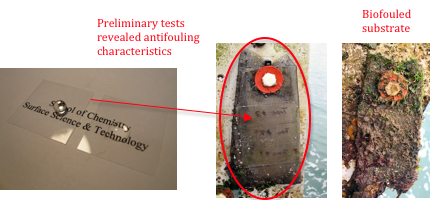Superhydrophobic Surfaces: A Green Antifouling Strategy
Alex Wu1, Andrew Scardino2, Michael Grunze3 and Robert N. Lamb1
1. School of Chemistry, University of Melbourne
2. Defence Science and Technology Organization (DSTO), Australian Government, Department of Defence
3. Department of Applied Physical Chemistry, University of Heidelberg, Germany
 Biofouling is a significant problem for all marine-related equipments, such as transportation vessels, offshore oil rigs and border patrol vessels. Excess biofouling disrupts marine operations by increasing fuel consumption of vessels and cleaning costs. It’s an issue that costs the marine industry billions of dollars annually. With the recent National Maritime Organization ban on toxic antifouling coatings such as tributyltin (TBT), environmentally friendly antifouling strategies are in high demand.
Biofouling is a significant problem for all marine-related equipments, such as transportation vessels, offshore oil rigs and border patrol vessels. Excess biofouling disrupts marine operations by increasing fuel consumption of vessels and cleaning costs. It’s an issue that costs the marine industry billions of dollars annually. With the recent National Maritime Organization ban on toxic antifouling coatings such as tributyltin (TBT), environmentally friendly antifouling strategies are in high demand.
Superhydrophobic non-stick surfaces are inherently ‘non-wetting’, which implies that water and its constituents such as marine species cannot adhere to such surfaces1. While it is intuitive to think that the probability of biofouling is linked to how readily a surface wets, biofouling is a complex process that involves multiple marine species and metabolic pathways. We’ve previously showed that superhydrophobic surfaces, regardless of its non-wetting characteristics, will eventually succumb to biofouling2.
Through a recent comprehensive study, we have shown that different superhydrophobic surfaces possessed varying degrees of antifouling behaviour, which correlated with surface nano-roughness3. To date, our current studies suggest that different surface characteristics, such as surface chemistry, microroughness and nanoroughness, each govern a specific aspect of antifouling characteristic.
The aim of this project, in collaboration with DSTO and The University of Heidelberg, Germany, is to decipher the role of surface chemistry, microroughness and nanoroughness in governing antifouling characteristics. The ultimate goal is to develop a set of parameters that can be used to impart antifouling characteristics to a wide variety of substrates encompassing metals, ceramics, glass and polymers.

1. Marmur, A. Super-hydrophobicity fundamentals: Implications to biofouling prevention. Biofouling: The Journal of Bioadhesion and Biofilm Research 22, 107 – 115 (2006).
2. Zhang, H., Lamb, R. & Lewis, J. Engineering nanoscale roughness on hydrophobic surface-preliminary assessment of fouling behaviour. Science and Technology of Advanced Materials 6, 236-239 (2005).
3. Scardino, A. J., Zhang, H., Cookson, D. J., Lamb, R. N. & Nys, R. d. The role of nano-roughness in antifouling. Biofouling: The Journal of Bioadhesion and Biofilm Research 25, 757 – 767 (2009).